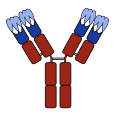Overview of and topical guide to immunology
The following outline is provided as an overview of and topical guide to immunology:
Immunology immune system in all organisms .[1] physiological functioning of the immune system in states of both health and disease; malfunctions of the immune system in immunological disorders (autoimmune diseases , hypersensitivities , immune deficiency , transplant rejection ); the physical, chemical and physiological characteristics of the components of the immune system in vitro , in situ , and in vivo .
Essence of immunology
Immunology
Branches of immunology: 1. General Immunology
2. Basic Immunology
3. Advanced Immunology
4. Medical Immunology
5. Pharmaceutical Immunology
9. Clinical Immunology
6. Environmental Immunology
8. Cellular and Molecular Immunology
9. Food and Agricultural Immunology
Molecules of the immune system
Immune receptors
See also: List of immune receptors
Antigen receptors
Accessory molecule (CD79 )
Pattern recognition receptors (PRRs)
Pattern recognition receptor
See also: List of pattern recognition receptors
MSR1 (SCARA1)MARCO (SCARA2)SCARA3
SCARA4 (COLEC12)
SCARA5 Class B - Two transmembrane domains
NLRA (A for acidic transactivating domain)
Complement receptors
Complement receptor
Fc receptors
Fc receptor
See also: List of Fc receptors
Cytokine receptors
Cytokine receptor
See also: List of cytokine receptors
EPOR (Erythropoietin receptor) - HomodimerG-CSFR (CD114) - Homodimer upon ligand bindingMPL (CD110, Thrombopoietin receptor) - Homodimer upon ligand bindingGHR (Growth hormone receptor) - Homodimer upon ligand bindingPRLR (Prolactin receptor)
C chemokine receptors (XCRs) CX3 C chemokine receptors (CX3 CRs)
Natural killer cell receptors
Natural killer cell receptors
Natural cytotoxicity receptors (NCRs) Natural killer group 2 receptors (NKG2s)
Two domains, long cytoplasmic tail Two domains, short cytoplasmic tail Three domains, long cytoplasmic tail Three domains, short cytoplasmic tail
Others
Antibodies
Antibodies
Cytokines
Cytokine
CX3 CL1 (Fractalkine, Neurotactin)
By family
By function/
MHCs
Major histocompatibility complex
Complement proteins
Early stage (divided by pathway)
Complement pathway inhibitors
Antimicrobial peptides
Antimicrobial peptides
Transcription factors
T-bet - TH 1 differentiationGATA3 - TH 2 differentiationRORγT - TH 17 differentiationBCL6 - TFH differentiationFoxP3 - Treg differentiation
Signaling pathways
Cell adhesion molecules (CAMs)
Cell adhesion molecules
See also: List of cell adhesion molecules
Leukocyte-adhesion receptor: Very late antigen receptor:
Others
CD80 - Expressed by APCsCD86 - Expressed by APCsCD28 family receptors CD28 - Expressed by T CellsCD278 (ICOS) - Homodimer, expressed by T CellsCTLA-4 (CD152)PD-1 (CD279)